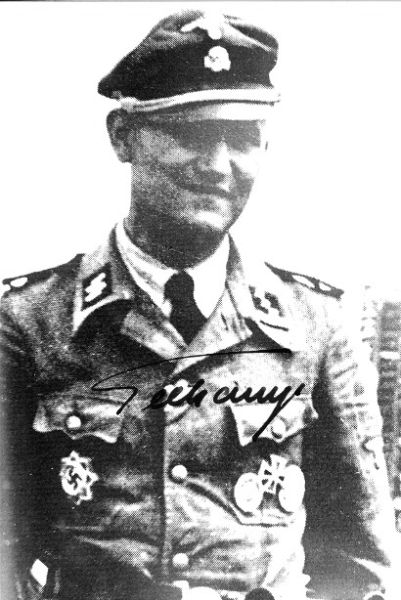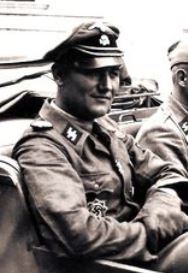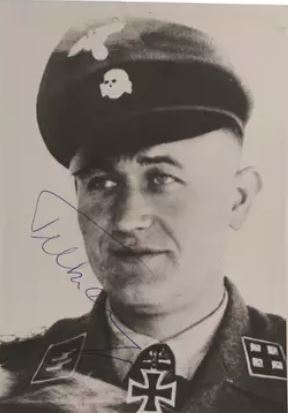Telkamp, Eberhard (Waffen SS)
- Date of birth:
- May 8th, 1914 (Ihrhove, Leer, Eastern-Friesland, Germany)
- Date of death:
- April 20th, 1992 (Rückholz-Nesselwang/Bavaria, Germany)
- Service number:
- SS-Nr.: 202.741 // NSDAP-Nr.:
- Nationality:
- German
Biography
Promotions:
04.05.1936: SS-Mann
20.04.1937: SS-Sturmmann
01.09.1937: SS-Rottenführer
24.02.1939: SS-Junker
15.06.1939: SS-Standartenjunker
01.09.1939: SS-Standartenoberjunker
09.11.1939: SS-Untersturmführer
20.04.1941: SS-Obersturmführer der Waffen-SS
30.01.1943: SS-Hauptsturmführer der Waffen-SS
21.06.1944: SS-Sturmbannführer der Waffen-SS
00.00.1945: SS-Obersturmbannführer der Waffen-SS
Career:
00.09.1932-00.12.1933: Hitlerjugend
20.12.1933: joined the SS, 10. Sturm, 24.SS-Standarte in Oldenburg
04.05.1936: SS-Mann, 9. Sturm, SS-Standarte 'Germania', SS-VT
00.00.1936: SS-Schütze, 4. Sturm, SS-Standarte 'Germania, SS-VT
00.09.1937: SS-Rottenführer, 12. Sturm, SS-Standarte 'Germania, SS-VT
00.00.1937: Führeranwärter-Lehrgang, SS-Unterführerschule Radolfzell
15.11.1938-00.08.1939: SS-Junker, SS-Junkerschule Bad Tölz
00.09.1939: SS-Ustuf, Artillerie-Lehrang, Artillerie-Schule
15.10.1939: SS-Ustuf, Batterieoffizier, 1. Batterie, I. Abteilung, SS-Artillerie-Regiment, SS-VT
00.05.1940: campaign in France
00.11.1940: SS-Ustuf, Adjutant, 1. Batterie, I. Abteilung, SS-Artillerie-Regiment, SS-VT
00.01.1941: SS-Ustuf, Sturmgeschütz-Lehrgang, Artillerie-Schule
00.02.1941: SS-Ustuf, Zugführer, I. Zug, SS-Sturmgeschütz-Batterie, SS-Artillerie-Regiment, SS-Division 'Reich' - campaign in the Balkans
00.06.1941: campaign in Russia
02.07.1941: SS-Ostuf, WIA by shell fragments
09.07.1941-24.08.1941: SS-Ostuf, Chef, SS-Sturmgeschütz-Batterie, SS-Artillerie-Regiment 'Reich'
07.09.1941: SS-Ostuf, WIA by shell fragments
08.10.1941-00.01.1942: SS-Ostuf, Chef, SS-Sturmgeschütz-Batterie, SS-Artillerie-Regiment, SS-Division 'Reich'
00.02.1942: SS-Ostuf, Chef, 10. Batterie, SS-Artillerie-Regiment, SS-Division 'Das Reich'
00.10.1942-00.05.1943: SS-Ostuf, Chef, 1. Batterie, SS-Sturmgeschütz-Abteilung 2, 2. SS-Panzergrenadier-Division 'Das Reich'
00.05.1943: SS-Hstuf, Führer, Sturmgeschüz-Lehrgang, SS-Sturmgeschütz-Ausbildungs- und Ersatz Abteilung
15.06.1943-00.11.1943: SS-Hstuf, Führer, SS-Sturmgeschüz-Abteilung 9, 9. SS-Panzer-Division 'Hohenstaufen'
15.11.1943: SS-Hstuf, Führer, II. Abteilung, SS-Panzer-Regiment 9, 9. SS-Panzer-Division 'Hohenstaufen'
26.07.1944: SS-Stubaf, Führer, I. Abteilung, SS-Panzer-Regiment 9, 9. SS-Panzer-Division 'Hohenstaufen'
00.08.1944: awarded the RK for the destruction of 100 British tanks in twenty days by his II. Abteilung command in June/July 1944
15.08.1944: SS-Stubaf, WIA
15.09.1944-00.05.1945: SS-Stubaf, Führer, SS-Panzer-Regiment 9, 9. SS-Panzer-Division 'Hohenstaufen'
Do you have more information about this person? Inform us!
- Period:
- Second World War (1939-1945)
- Awarded on:
- 1938
- Period:
- Second World War (1939-1945)
- Rank:
- SS-Untersturmführer (2nd Lieutenant)
- Unit:
- Batterieoffizier, 1. Batterie, I. Abteilung, SS-Artillerie-Regiment, SS-VT
- Awarded on:
- June 3rd, 1940
- Period:
- Second World War (1939-1945)
- Rank:
- SS-Untersturmführer (2nd Lieutenant)
- Unit:
- Batterieoffizier, 1. Batterie, I. Abteilung, SS-Artillerie-Regiment, SS-VT
- Awarded on:
- October 21st, 1940
- Period:
- Second World War (1939-1945)
- Rank:
- SS-Untersturmführer (2nd Lieutenant)
- Awarded on:
- March 31st, 1941
- Period:
- Second World War (1939-1945)
- Rank:
- SS-Obersturmführer (Lieutenant)
- Unit:
- Zugführer, I. Zug, SS-Sturmgeschütz-Batterie, SS-Artillerie-Regiment
- Awarded on:
- July 5th, 1941
- Period:
- Second World War (1939-1945)
- Rank:
- SS-Obersturmführer (Lieutenant)
- Unit:
- Chef, SS-Sturmgeschütz-Batterie, SS-Division “Das Reich”
- Awarded on:
- February 28th, 1942
“On June 30, 1941, Telkamp’s platoon was assigned to the II./Deutschland which marched as the lead battalion. The Kradschützen Bataillon was surrounded at Losza and Telkamp’s orders were to free them and clear the road for our advance. On the way one vehicle developed engine trouble so Telkamp’s was the only one available. He destroyed two Russian tanks before arriving at the village and establishing contact with the Kradschützen Bataillon. Telkamp destroyed three more thanks and four anti-tank guns that ended all resistance.
On July 1, 1941, Telkamp assisted greatly while attached to the III./Deutschland during the Puchowicze fighting. The village and bridge were already taken by the Aufklärungsabteilung. Telkamp’s unit silenced strong enemy attacks from the woods beyond the bridge. Eight tanks, five anti-tank guns, and a large number of machine guns were destroyed.
On July 2, 1941, the orders were to advance with the III./Deutschland towards Jaczizy via Perewos and capture the bridge across the Beresina River. Perewos was taken in hard fighting. Four enemy tanks, two anti-tank guns, and columns of infantry were destroyed during the advance. The Russian troops holding the town tried to escape across the bridge. Despite heavy fire, Telkamp drove his vehicle onto the bridge that was full of enemy troops. Firing constantly, the bridge was blown up when he was a third of the way across. The assault gun fell into the river but, despite his own wounds, Telkamp was able to rescue his crew. The total for the day was eight tanks, three anti-tank guns, and an artillery piece destroyed in addition to enemy infantry killed.
On July 24, 1941, Obersturmführer Telkamp led all the remaining assault-guns in the attack on Uschakowa. Through his brave action the attack was finished successfully against a strong opponent without severe own losses and in the shortest time.
On September 16, 1941, Telkamp’s platoon advanced towards Priluki with the 15./Der Führer. Without infantry support they penetrated into the town to the second bridge. While being briefed on the situation, Telkamp noticed the enemy advance to his rear area and employed his platoon in such a way that the Russians were scattered. Two anti-aircraft guns, a tank, four anti-tank guns, 19 artillery pieces and a large number of transport vehicles were destroyed. Telkamp was wounded for the second time that month when his vehicle hit a mine.”
- Period:
- Second World War (1939-1945)
- Awarded on:
- 1942
- Period:
- Second World War (1939-1945)
- Rank:
- SS-Obersturmführer (Lieutenant)
- Awarded on:
- August 5th, 1942
- Period:
- Second World War (1939-1945)
- Rank:
- SS-Hauptsturmführer (Captain)
- Awarded on:
- February 28th, 1943
- Period:
- Second World War (1939-1945)
- Rank:
- SS-Sturmbannführer (Major)
- Unit:
- Führer, II. Abteilung, SS-Panzer-Regiment 9, 9.SS-Panzer-Division “Hohenstaufen”, II. SS-Panzer-Korps, Heeresgruppe B
- Awarded on:
- August 23rd, 1944
“SS-Sturmbannführer Telkamp has already distinguished himself in the East during the operation against Tarnopol as the commander of the newly formed II./SS-Pz.Rgt. 9, part of the young Panzer-Regiment ‘Hohenstaufen’. It is to his sole credit that the armoured breakthrough south of Horodyce (on the 14.04.1944) succeeded in advancing as far as Chodackow Wielki.
While serving in the west, Telkamp and his Abteilung destroyed 100 enemy tanks in the time period 29.06.-18.07.1944. These results were achieved in hard offensive and defensive battles against hitherto unseen enemy power, and in terrain that was relatively unsuitable for armoured operations no less. These results are in large part due to the personal merit of the Abteilung commander. His tireless activity during personal reconnaissance of the terrain, his precise instructions to his units, the skillful supervision and coordination of his Kompanien, and above all his constant personal presence at the hotspots of the fighting enabled these results to be achieved. By these attributes Telkamp has a decisive share in the tactical successes of the Division.
One of these was his thrust into the enemy flank during the first combat phase, which prevented the enemy from achieving their objective of Hill 112. The enemy, who had already reached the reverse slope of Hill 112 during the course of the 01.07.1944 with a force of 62 counted AFVs, was forced to fall back due to the heavy tank losses (24) inflicted by the II./SS-Pz.Rgt. 9.
Through their renewed tank losses on the 01.07.1944 (36), the enemy pressure on the I. SS-Pz.Korps near Caen was reduced enough to a point where the threat of a possible encirclement was averted.
Through the counterattack of the II./SS-Pz.Rgt. 9 (42 Panzers) against Eterville on the 10.07.1944, conducted after a forced march from the rear via Maltot, the enemy pressure against Hills 112 and 113 was reduced enough that these hills could be held.
During the counterattack against Bougy on the 16.07.1944, the Panzers of the II./SS-Pz.Rgt. 9 reached the first attack objective ahead of the Grenadiers in a bold thrust. 20 enemy tanks were destroyed in this area. Thereafter, in cooperation with the Aufklärungs-Abteilung 9, elements of the II./SS-Pz.Rgt. 9 (27 Panzers) were dispatched to eliminate a penetration at Noyers. They are credited with a major share in the defensive victory against the repeated enemy thrusts (which had strong tank support).
Maps with the kill claim locations, as well as combat reports, are attached.”
based on recommendation dated 21.07.1944 and signed by SS-Obersturmbannführer Otto Meyer, Kdr. SS-Panzer-Regiment 9
Sources
- Photo 1: Willi Schumacher Collection
- Photo 2:
- Photo 3:
- - FELLGIEBEL, W.P., Elite of theThird Reich, Helion & Company Limited, Solihull, 2003.
- PATZWALL, K. & SCHERZER, V., Das Deutsche Kreuz 1941-1945, Band II, Verlag Klaus D. Patzwall, Norderstedt, 2001.
- SCHNEIDER, J.W., Their Honor Was Loyalty!, Bender (R.James) Publishing, 1993.
- Microfilm Publication A3343. US National Archives.



















